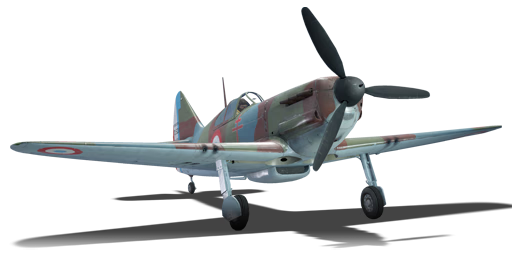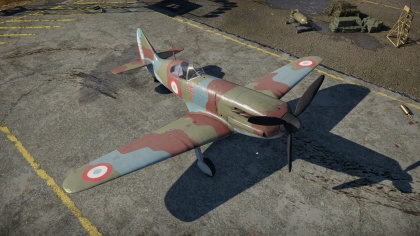D.520 (Great Britain)
Contents
| This page is about the gift British fighter version D.520 (Great Britain). For the version in the French tree, see D.520. |
Description
The ▄D.520 is a rank II gift British fighter
with a battle rating of 3.0 (AB/RB) and 2.3 (SB). This aircraft has been in the game since the start of the Open Beta Test prior to Update 1.29. Unfortunately, this vehicle is currently unavailable to players who want to purchase it due to it being removed from shop.
General info
Flight Performance
| Characteristics | |||||||
|---|---|---|---|---|---|---|---|
| Stock | |||||||
| Max Speed (km/h at 5,000 m) |
Max altitude (meters) |
Turn time (seconds) |
Rate of climb (meters/second) |
Take-off run (meters) | |||
| AB | RB | AB | RB | AB | RB | ||
| 521 | 518 | 11200 | 22.7 | 21.7 | ??.? | 7.3 | 300 |
| Upgraded | |||||||
| Max Speed (km/h at 5,000 m) |
Max altitude (meters) | Turn time (seconds) | Rate of climb (meters/second) |
Take-off run (meters) | |||
| AB | RB | AB | RB | AB | RB | ||
| 572 | 550 | 11200 | 18.8 | 20.0 | 15.9 | 10.0 | 300 |
Details
| Features | ||||
|---|---|---|---|---|
| Combat flap | Take-off flap | Landing flap | Air brakes | Arrestor gear |
| ✓ | ✓ | ✓ | X | X |
| Limits | ||||
|---|---|---|---|---|
| Wing-break speed (km/h) |
Gear limit (km/h) |
Combat flap (km/h) |
Max Static G | |
| + | - | |||
| 0 | 320 | 400 | ~18 | ~15 |
| Optimal velocities | |||
|---|---|---|---|
| Ailerons (km/h) |
Rudder (km/h) |
Elevators (km/h) |
Radiator (km/h) |
| < 400 | < 430 | < 460 | > 250 |
| Compressor (RB/SB) | ||
|---|---|---|
| Setting 1 | ||
| Optimal altitude | 100% Engine power | WEP Engine power |
| 4,000 m | 920 hp | 976 hp |
Survivability and armour
- 38 mm Bulletproof glass in front of the pilot.
- 8 mm Steel plate behind pilot.
- 3 mm Steel box behind pilot's head.
- Critical components located at the front of aircraft (fuel, pilot, engine, controls)
- More fuel tanks located in wings near the fuselage
Armaments
Offensive armament
The D.520 (Great Britain) is armed with:
- 1 x 20 mm Hispano 404 cannon, nose-mounted (60 rpg)
- 4 x 7.5 mm MAC 1934 machine gun, wing-mounted (675 rpg = 2,700 total)
Usage in the battles
The main purpose of the D.520 is the role of an interceptor/fighter. It has no bomb-capacity and thus stands limited to aerial combat. In this respect, there are a few things to consider, first and foremost that this is a fighter that does not do great away from a squad. It has mediocre flight characteristics as far as speed, climb and turn are concerned. It is however quite well armoured to compensate for such, meaning that it will stay air-worthy where other aircraft would crash, and instead stands a fighter which is effective in engagements where it has support to rely on. Without such support, it is a very situational plane which can engage certain enemies depending on advantage in altitude, speed, or sometimes even a turning radius. It has a respectable armament of one powerful Hispano 20 mm cannon with a very limited ammunition load (60 rounds), and four 7.5 mm guns with a good deal of ammunition which makes it competitive in realistic battles. Its strong airframe is able to withstand significant wind resistance making it potent in a longer dive. Despite its limited attributes, it handles fairly comfortably and thus can be a real asset to a pilot which employs situational awareness combined with an in-depth understanding of the enemy aircraft he will choose to either engage or avoid. It has a potent incendiary tracer round for its machine guns and the Hispano makes it pack a fairly significant punch despite its limited cannon ammunition. The D.520 is best considered a heavier single-seat fighter aircraft which can out-endure other enemy squads due to its armour, but not out-turn, out-run, out-gun many other types of aircraft on its own rank.
Manual Engine Control
| MEC elements | ||||||
|---|---|---|---|---|---|---|
| Mixer | Pitch | Radiator | Supercharger | Turbocharger | ||
| Oil | Water | Type | ||||
| Controllable | Controllable | Not controllable | Controllable | Combined | Not ontrollable | Not controllable |
Modules
| Tier | Flight performance | Survivability | Weaponry | ||
|---|---|---|---|---|---|
| I | Fuselage Repair | Radiator | |||
| II | Compressor | Airframe | |||
| III | Wings Repair | Engine | |||
| IV | Engine Injection | Cover | |||
Pros and cons
Pros:
- Powerful 20mm cannon
- Good fighter armament
- Plenty of ammo for the machine-guns
- Very incendiary ammunition for its tracer ammunition
- Fairly good armour
Cons:
- Neither very manoeuvrable or very fast
- Very little ammo for the 20mm cannon (60 rounds)
- Relatively poor rate of climb
- Very situational aircraft
- Takes a lot of machine gun rounds to shoot down an enemy plane when you run out of cannon ammo
History
Production-standard armament consisted of a 20 mm HS.404, with an ammunition capacity of 60 rounds, firing through the propeller hub, and four belt-fed MAC 1934 M39 7.5 mm (.295 in) machine guns in the wings, each with 675 rounds per gun. The MAC 1934 machine guns had a high rate of fire of 1,200 rounds per minute (rpm), while the effective HS.404 fired at 600 rpm and was accurate up to 500 m (1,600 ft); the ammunition capacity meant that the machine guns could be fired for a total of 30 seconds, while the cannon had 10 seconds worth of ammunition. In combat the MS.406 had only two 7.5 mm and was, therefore, at a disadvantage when the HS.404 had used up its ammunition, while a D.520 could continue to fight effectively because it had four fast-firing machine guns (over 80 rounds/sec), with 20+ seconds of ammunition still available. The D.520 had provisions for two BE33 "illuminating bombs", useful for nocturnal interception missions, but these were seldom used because French fighters rarely flew night-time missions.
In-game description
The Dewoitine D.520 was a French single-seat, all-metal, monoplane fighter which first entered service in 1940. In 1936 the French Armee de l’Air stated a requirement for a cannon armed fighter capable of speeds of 500 km/h. Emile Dewoitine began work on a design to meet this criteria and a prototype D.520-01 conducted its first test flight on October 2nd 1938. After some initial teething problems, the first production run was started in October 1939. In April 1940 the first D.520s were declared operational in Groupe de Chasse 1/3, a Groupe which already included a good number of combat experienced pilots.
The Dewoitine D.520 was powered by a liquid-cooled Hispano-Suiza HS12Y-45 engine, rated at 920 hp. Its armament comprised of one Hispano-Suiza HS404 20mm cannon with 60 rounds and four belt-fed MAC 1934 M39 7.5mm machine guns in the wings with 675 rounds each.
The outbreak of war had made any further refinement of the aircraft impossible, and as a result production commenced with minimal delays, leaving no time for proposed improvements to be implemented. Instead, upgrades would be made during production, as time allowed. The production model had a redesigned carburettor air intake and a modified cooling system for the engine. Later D.520s featured jet exhaust pipes. The production model was sometimes referred to as the D.520S (""serial"") or the D.520C1 (""chausser 1"" - single-seat fighter).
The Dewoitine D.520 flew its first operational sorties in May 1940 and the majority of its victories (18 confirmed kills) were achieved by one of the leading French aces, Adjudant-Chief (then Sous-Lieutenant) Pierre Le Gloan from GC III/6. Production of the D.520 was halted when France surrendered in the summer of 1940 and then restarted under German occupation in April of 1941.
From September 1942, the D.520 was the main fighter of Vichy France; the puppet French government who now collaborated with Nazi Germany. From April 1941 onward D.520s took part in clashes with British forces in Lebanon and Syria. In November of 1942, some D.520s joined la France Libre and fought for the Allies in North Africa. The D.520 also served with the Luftwaffe, and the Germans supplied the fighters to their allies in Italy, Bulgaria, and Romania.
The Dewoitine D.520 is considered by many to be the best French fighter of World War II. Its initial competition included the Spitfire and the Messerschmitt 109, although its handling characteristics and performance were inferior to both. One senior British test pilot described it as underpowered, ‘a nasty little brute’ to fly and markedly inferior to both the Spitfire and Hurricane.
D.520 fighters were mass manufactured intermittently until June 1944 and in all 610 were produced. The last D.520s, used as trainers, were retired by the Armee de l’Air in September 1953.
Media
An excellent addition to the article will be video guides, as well as screenshots from the game and photos.
Read also
Links to the articles on the War Thunder Wiki that you think will be useful for the reader, for example,
- reference to the series of the aircraft;
- links to approximate analogues of other nations and research trees.
Sources
Paste links to sources and external resources, such as:
- topic on the official game forum;
- page on aircraft encyclopedia;
- other literature.
| Dewoitine (SNCAM/SNCASE) | |
|---|---|
| Fighters | |
| D.37 | D.371 · D.371 H.S.9 · D.373 |
| D.500 | D.500 · D.501 · Pallier's D.510 |
| D.520 | D.520 · ▄D.520 · ▄D.521 |
| Export | ␗D.510C |
| Britain premium aircraft | |
|---|---|
| Fighters | Tuck's Gladiator Mk II · ▄Boomerang Mk I · ▄Boomerang Mk II · ▄D.520 |
| ▄Martlet Mk IV · ▄Corsair F Mk II · ▄Hellcat Mk II · ▄Thunderbolt Mk.1 · ▄Mustang Mk IA | |
| Hurricane Mk.I/L FAA M · Spitfire Mk.IIa Venture I · Spitfire F Mk IXc · Plagis' Spitfire LF Mk IXc · Spitfire F Mk XIVc · Prendergast's Spitfire FR Mk XIVe | |
| Typhoon Mk Ib · MB.5 | |
| Twin-engine fighters | Hornet Mk.I · Whirlwind P.9 |
| Jet fighters | Attacker FB.2 · Hunter FGA.9 · Lightning F.53 · Meteor F Mk.8 Reaper · Sea Vixen F.A.W. Mk.2 · F-4J(UK) Phantom II · ▄MiG-21 Bison |
| Strike aircraft | ▄Wirraway · Beaufighter Mk I (40-mm) · Wyvern S4 |
| Harrier GR.1 · Strikemaster Mk.88 | |
| Bombers | ▄Avenger Mk II · ▄Boston Mk I · ▄Catalina Mk IIIa · ▄DB-7 · ▄Havoc Mk I · ▄Hudson Mk V · Swordfish Mk II |





